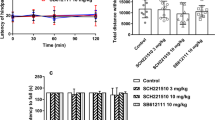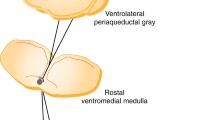Abstract
Rationale
Sex differences in the potency of the antinociceptive effects of κ opioids have been reported in various acute pain models with evidence suggesting that these sex differences are mediated by activity in the N-methyl-d-aspartate (NMDA) system.
Objectives
The purpose of the present study was to evaluate sex differences in the antihyperalgesic actions of selected κ and mixed-action opioids in a persistent pain model and determine if the NMDA system modulates these effects in a sexually dimorphic manner.
Methods
Using gonadally intact male and female F344 rats, hyperalgesia was induced by local administration of capsaicin in the tail, after which the tail was immersed in a mildly noxious thermal stimulus (45°C water), and tail-withdrawal latency measured. Opioids were then administered systemically (s.c.) and locally (in the tail) alone, and in selected combinations with the noncompetitive NMDA antagonist dextromethorphan.
Results
When administered systemically and locally, the κ opioids spiradoline, U69,593 and U50,488, and the mixed-action opioids butorphanol and nalbuphine, produced dose-dependent antihyperalgesic effects. Whereas the κ opioids were generally more potent in males, sex differences were not observed with the mixed-action opioids. Peripheral receptor activity was confirmed for local administration of κ opioids by the antagonism observed after local, but not intracerebroventricular (i.c.v.), administration of the κ antagonist nor-binaltorphamine (nor-BNI). Dextromethorphan was equally potent in attenuating the antihyperalgesia induced by κ opioids in both males and females.
Conclusions
These findings demonstrate sex differences in κ opioid activity in a persistent pain model. Although an NMDA antagonist blocked the effects of κ opioids in this model, these effects were not sexually dimorphic as reported in most acute pain models.









Similar content being viewed by others
References
Antonijevic I, Mousa AS, Schafer M, Stein C (1995) Perineurial defect and peripheral opioid analgesia in inflammation. J Neurosci 15:165–172
Barrett AC (2006) Low efficacy opioids: implications for sex differences in opioid antinociception. Exp Clin Psychopharmacol 14:1–11
Barrett AC, Smith ES, Picker MJ (2002) Sex-related differences in mechanical nociception and antinociception produced by μ- and κ-opioid receptor agonists in rats. Eur J Pharmacol 452:163–173
Barrett AC, Smith ES, Picker MJ (2003) Capsaicin-induced hyperalgesia and mu opioid-induced antihyperalgesia in male and female rats. J Pharmacol Exp Ther 307:237–245
Binder W, Carmody J, Walker J (2000) Effect of gender on anti-inflammatory and analgesic actions of two κ-opioids. J Pharmacol Exp Ther 292:303–309
Butelman ER, Ko M-C, Sobczyk-Kojiro K, Mosberg HI, van Bemmel B, Zernig G, Woods JH (1998) Kappa-opioid receptor binding populations in rhesus monkey brain: relationship to an assay of thermal antinociception. J Pharmacol Exp Ther 285:595–601
Clemente JT, Parada CA, Veiga MC, Gear RW, Tambeli CH (2004) Sexual dimorphism in the antinociception mediated by kappa opioid receptors in the rat temporomandibular joint. Neurosci Lett 372:250–255
Cook CD, Nickerson MD (2005) Nociceptive sensitivity and opioid antinociception and antihyperalgesia in Freund’s adjuvant-induced arthritic male and females rats. J Pharmacol Exp Ther 313:449–459
Cook CD, Barrett AC, Roach EL, Bowman JR, Picker MJ (2000) Sex-related differences in the antinociceptive effects of opioids: importance of rat genotype, nociceptive stimulus intensity and efficacy at the μ opioid receptor. Psychopharmacology 150:430–442
Craft RM (2003) Sex differences in opioid analgesia: “from mouse to man”. Clin J Pain 19:175–186
Craft RM, Bernal SA (2001) Sex differences in opioid antinociception: kappa and ‘mixed action’ agonists. Drug Alcohol Depend 63:215–228
Craft R, Lee D (2005) NMDA antagonist modulation of morphine antinociception in female vs. male rats. Pharmacol Biochem Behav 80:639–649
Danysz W, Essmann U, Bresink R (1994) Glutamate antagonists have different effects on spontaneous locomotor activity in rats. Pharmacol Biochem Behav 48:111–118
Dykstra LA (1990) Butorphanol, levallorphan, nalbuphine and nalorphine as antagonists in the squirrel monkey. J Pharmacol Exp Ther 214:245–252
Eisenberg E, Vos BP, Strassman AM (1993) The NMDA antagonist memantine blocks pain behavior in a rat model of formalin induced facial pain. Pain 54:301–307
Falcon M, Guendellman D, Stolberg A, Frenk H, Urca G (1996) Development of thermal nociception in rats. Pain 67:203–208
Holtman JR Jr, Wala EP (2006) Characterization of the antinociceptive effect of oxycodone in male and female rats. Pharmacol Biochem Behav 83:100–108
Holtman JR Jr, Jing X, Wala EP (2003) Sex related differences in the enhancement of morphine antinociception by NMDA receptor antagonists in rats. Pharmacol Biochem Behav 76:285–293
Holzer P (1991) Capsaicin: cellular targets, mechanisms of action and selectivity for thin sensory neurons. Pharmacol Rev 43:143–201
Ji RR, Zhang Q, Law PY, Low HH, Elde R, Hokfelt T (1995) Expression of mu, delta and kappa opioid receptor like immunoreactivities in rat dorsal root ganglia after carrageenan-induced inflammation. J Neurosci 15:8156–8166
Joshi SK, Gebhart GF (2003) Nonopioid actions of U50,488 enantiomers contribute to their peripheral cutaneous antinociceptive effects. J Pharmacol Exp Ther 305:919–924
Kavaliers M, Choleris E (1997) Sex differences in N-methyl-D-aspartate involvement in κ opioid and non-opioid predator-induced analgesia in mice. Brain Res 768:30–36
Kavaliers M, Galea L (1995) Sex differences in the expression and antagonism of swim stress-induced analgesia in deer mice vary with the breeding season. Pain 63:327–334
Ko MCH, Johnson MD, Butelman ER, Willmont KJ, Mosberg HI, Woods JH (1999) Intracisternal nor-binaltorphimine distinguishes central and peripheral kappa-opioid antinociception in rhesus monkeys. J Pharmacol Exp Ther 291:1113–1120
Ko MCH, Tuchman JE, Johnson MD, Wiesanuer K, Woods JH (2000) Local administration of mu or kappa opioid agonists attenuates capsaicin-induced thermal hyperalgesia via peripheral opioid receptors in rats. Psychopharmacology 148:180–185
Kumor KM, Haertzen CA, Johnson RE, Kocher T, Jasinski D (1986) Human psychopharmacology of ketocyclazocine as compared with cyclazocine, morphine and placebo. J Pharmacol Exp Ther 238:960–968
Le Bars D, Gozariu M, Cadden SW (2001) Animal models of nociception. Pharmacol Rev 53:597–652
McCall WD, Tanner KD, Levine JD (1996) Formalin induces biphasic activity in C-fibers in the rat. Neurosci Lett 208:45–48
Mogil JS, Wilson SG, Chesler EJ, Rankin AL, Nemmani KVS, Lariviere WR, Groce MK, Wallace MR, Kaplan L, Staud R, Ness TJ, Glover TL, Stankova M, Mayorov A, Hruby VJ, Grisel JE, Fillingim RB (2003) The melanocortin-1 receptor gene mediates female specific mechanisms of analgesia in mice and humans. Proc Natl Acad Sci USA 100:4867–4872
Nishimura W, Tadatoshi M, Tatsumi S, Sakimura K, Mishina M, Minami T, Ito S (2004) Characterization of N methyl-D-aspartate receptor subunits responsible for post operative pain. Eur J Pharmacol 503:71–75
Paxinos G, Watson C (1986) The rat brain in stereotaxic coordinates. Academic, San Diego
Plesan A, Hedman U, Xu X-J, Wiesenfeld-Hallin Z (1998) Comparison of ketamine and dextromethorphan in potentiating the antinociceptive effect of morphine in rats. Anesth Analg 86:825–829
Przewlocki R, Przewlocka B (2001) Opioids in chronic pain. Eur J Pharmacol 429:79–91
Redwine KE, Trujillo KA (2003) Effects of NMDA receptor antagonists on acute opioid analgesia in the rat Pharmacol Biochem Behav 76:361–372
Richardson JD, Vasko MR (2002) Cellular mechanisms of neurogenic inflammation J Pharmacol Exp Ther 302:839–845
Rimoy GH, Bhaskar NK, Wright DM, Rubin PC (1991) Mechanism of diuretic action of spiradoline (U-62066E)–a kappa opioid receptor agonist in the human. Br J Clin Pharmacol 32:611–615
Sakurada R, Wako K, Sguiyama A, Sakurada C, Tan-Ho K, Kisara K (1998) Involvement of spinal NMDA receptors in capsaicin-induced nociception. Pharmacol Biochem Behav 59:339–345
Sternberg WF, Chesler EJ, Wilson SG, Mogil JS (2004) Acute progesterone can recruit sex-specific neurochemical mechanisms mediating swim stress-induced and kappa-opioid analgesia in mice. Horm Behav 46:467–473
Tallarida RJ, Murray RB (1987) Manual of pharmacologic calculations with computer programs. Springer, Berlin Heidelberg New York
Yaksh TL (1997) Pharmacology and mechanisms of opioid analgesic activity. Acta Anaesthesiol Scand 41:94–111
Zollner C, Shaqura MA, Bopaiah CP, Mousa S, Stein C, Schafer M (2003) Painful inflammation-induced increase in mu-opioid receptor binding and G-protein coupling in primary afferent neurons. Mol Pharmacol 64:202–210
Acknowledgements
Animals used in this study were cared for in accordance with the guidelines of the Institutional Animal Care and Use Committee of the University of North Carolina at Chapel Hill and the “Guide for the Care of and Use of Laboratory Animals” (Institute of Laboratory Animal Resources, National Academy Press, 1996). This work was supported by the National Institute on Drug Abuse (NIDA) Grant DA10277 awarded to M.J.P and NIDA grant DA15709 awarded to D.T.L. L.M.L was supported by NIDA training Grant DA07244. A.C.B. was supported by NIDA predoctoral fellowship DA15273 and is currently at Cephalon, Frazer PA. J.M.T. was supported by NIDA predoctoral fellowship DA17404 and is currently a postdoctoral fellow in the Department of Psychiatry at the University of Chicago.
Author information
Authors and Affiliations
Corresponding author
Rights and permissions
About this article
Cite this article
Lomas, L.M., Barrett, A.C., Terner, J.M. et al. Sex differences in the potency of κ opioids and mixed-action opioids administered systemically and at the site of inflammation against capsaicin-induced hyperalgesia in rats. Psychopharmacology 191, 273–285 (2007). https://doi.org/10.1007/s00213-006-0663-1
Received:
Accepted:
Published:
Issue Date:
DOI: https://doi.org/10.1007/s00213-006-0663-1




